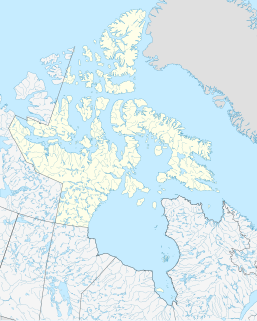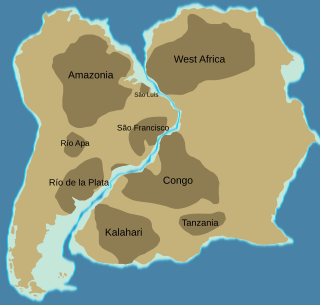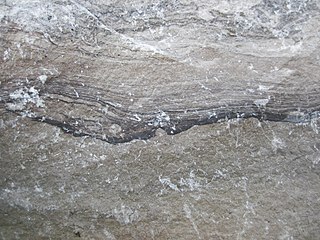
The Devonian is a geologic period and system of the Paleozoic, spanning 60.3 million years from the end of the Silurian, 419.2 million years ago (Mya), to the beginning of the Carboniferous, 358.9 Mya. It is named after Devon, England, where rocks from this period were first studied.

The Late Devonian extinction consisted of several extinction events in the Late Devonian Epoch, which collectively represent one of five largest mass extinction events in the history of life on Earth. The term primarily refers to a major extinction, the Kellwasser event, which occurred around 372 million years ago, at the boundary between the Frasnian stage and the Famennian stage, the last stage in the Devonian Period. Overall, 19% of all families and 50% of all genera became extinct. A second mass extinction, the Hangenberg event, occurred 359 million years ago, bringing an end to the Famennian and Devonian, as the world transitioned into the Carboniferous Period.

Tentaculites is an extinct genus of conical fossils of uncertain affinity, class Tentaculita, although it is not the only member of the class. It is known from Lower Ordovician to Upper Devonian deposits both as calcitic shells with a brachiopod-like microstructure and carbonaceous 'linings'. The "tentaculites" are also referred to as the styliolinids.

Melo is the capital city of the Cerro Largo Department of north-eastern Uruguay. As of the census of 2011, it is the ninth most populated city of the country.

"No No Song" is a 1974 song by English musician Ringo Starr. Written by Hoyt Axton and David Jackson, it appeared on Starr's 1974 album, Goodnight Vienna. It was released as a single in the US on 27 January 1975, backed with "Snookeroo," and reached No. 1 in Canada, #3 in the Billboard charts and reached No. 1 on Cash Box charts in the US.

Felipe Melo de Carvalho, known as Felipe Melo, is a Brazilian professional footballer who plays as a defensive midfielder for Fluminense.

Marcelo Pinheiro Davi de Melo is a Brazilian professional tennis player from Belo Horizonte. Primarily a doubles specialist, his career-high doubles ranking is No. 1, which he first reached in November 2015. Melo is the only Brazilian ever to top the ATP doubles rankings.

Psilophyton is a genus of extinct vascular plants. Described in 1859, it was one of the first fossil plants to be found which was of Devonian age. Specimens have been found in northern Maine, USA; Gaspé Bay, Quebec and New Brunswick, Canada; the Czech Republic; and Yunnan, China. Plants lacked leaves or true roots; spore-forming organs or sporangia were borne on the ends of branched clusters. It is significantly more complex than some other plants of comparable age and is thought to be part of the group from within which the modern ferns and seed plants evolved.

Bruno Fraga Soares is a Brazilian professional tennis player who specialises in doubles.

The Pope's Toilet is a 2007 Uruguayan film directed by César Charlone and Enrique Fernandez, starring César Troncoso, Virginia Méndez, and Mario Silva.

The Paraná Basin is a large cratonic sedimentary basin situated in the central-eastern part of South America. About 75% of its areal distribution occurs in Brazil, from Mato Grosso to Rio Grande do Sul states. The remainder area is distributed in eastern Paraguay, northeastern Argentina and northern Uruguay. The shape of the depression is roughly elliptical and covers an area of about 1,500,000 km2 (580,000 sq mi).

Okse Bay is an Arctic waterway in Qikiqtaaluk Region, Nunavut, Canada. It is located in Norwegian Bay by southwestern Ellesmere Island, east of Buckingham Island.
The Beaverhill Lake Group is a geologic unit of Middle Devonian to Late Devonian age in the Western Canada Sedimentary Basin that is present in the southwestern Northwest Territories, northeastern British Columbia and Alberta. It was named by the geological staff of Imperial Oil in 1950 for Beaverhill Lake, Alberta, based on the core from a well that they had drilled southeast of the lake, near Ryley, Alberta.

The country of Paraguay lies geologically at the borderzone between several cratons. Due to thick Cenozoic sediment cover and regolith development few outcrops are available in Paraguay. East of Paraguay River Precambrian and Early Paleozoic crystalline basement crop out mainly in the heights of Caapucú and Apa. The geological processes that have shaped Paraguay's bedrock and sedimentary basins are diverse including rifting, marine sedimentation, metamorphism, eruption of flood basalts and alkaline potassic volcanism.

Events in the year 1928 in Brazil.

The Detroit River Group is a geologic group in Michigan and Ohio. It preserves fossils dating back to the Devonian period.

Ctenacanthus is an extinct genus of ctenacanthiform chondrichthyan. Remains have been found in the Bloyd Formation in Arkansas, United States and in South America.
Cryptotaxis is an extinct genus of conodonts in the family Cryptotaxidae from the Famennian.

The Cordobés Formation is an Early Devonian geologic formation of the Durazno Group in the Paraná Basin in the Durazno Department of central Uruguay. The shallow marine shales preserve trilobite, bivalve, gastropod and brachiopod fossils.


















